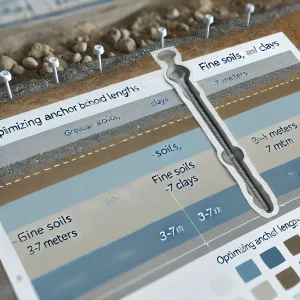In geotechnical engineering, the optimization of anchor bond lengths is crucial for both efficiency and cost-effectiveness. From granular soils to complex rock masses, anchor performance is heavily influenced by soil and rock type, ground conditions, and specific load requirements.
Here, we explore best practices for anchor bond length selection, drawing on foundational research from Ostermayer and current field applications. Whether you’re working in sands, clays, or fractured rocks, understanding how bond length impacts load transfer is essential for designing effective, resilient anchor systems.
Understanding Anchor Bond Length Limits
Ostermayer’s research set a benchmark in understanding how bond length influences anchor efficiency. His findings revealed that beyond a certain length—generally around 6-7 meters—bond lengths do not necessarily translate into proportional increases in load transfer. This insight is particularly relevant for granular soils, where the phenomenon known as progressive debonding occurs. In these cases, bond stress cannot fully mobilize along the extended length, resulting in diminishing returns on load-bearing capacity. This observation is essential for practical geotechnical design, as it underscores the importance of adapting bond lengths to specific ground conditions to avoid unnecessary costs and inefficiencies.
Optimized Bond Lengths by Soil Type
1. Granular Soils (Sands and Gravelly Soils)
In granular soils like sands and gravel, Ostermayer’s findings indicate that bond lengths between 3 to 7 meters are often sufficient. Longer bond lengths in these soils lead to progressive debonding, as load transfer saturates beyond a certain depth. For high-capacity anchor systems in granular soils, Single Bore Multiple Anchor (SBMA) configurations are recommended. These systems segment the bond into shorter, effective lengths within a single borehole, allowing for greater load mobilization and efficiency. SBMA systems are ideal for projects with stringent load requirements in cohesionless soils where traditional, single-length anchors may fall short.
2. Fine Soils (Clays)
In fine soils such as clays, particularly stiff or hard varieties, an optimal bond length generally ranges from 3 to 6 meters. Longer bond lengths in clays tend to lose efficiency due to strain softening, which reduces shear resistance along the bond over time. Anchors in cohesive soils primarily rely on side shear, so optimizing the bond length within this range ensures effective load transfer without unnecessary extension. In harder clays, under-reamed sections may be employed to increase end-bearing resistance, though this technique is most effective when cohesion alone may not be sufficient for load transfer, as in soils with partial granular content.
3. Rock Masses
Anchor behavior in rock is more complex, as it is influenced by the rock’s integrity, type, and degree of jointing. In hard, intact rocks like granite or limestone, bond lengths around 6 meters typically mobilize full anchor capacity. Longer lengths yield limited additional benefit due to a non-linear bond stress distribution. However, in weak or weathered rocks with jointing, shorter bond lengths—typically around 3 to 4 meters—are advisable. Extended lengths are less efficient in fractured rocks as jointing disrupts consistent load transfer along the bond. To improve efficiency in weaker rocks, careful grouting and shorter bond sections can enhance load capacity.
Reasons for Extended Bond Lengths in Practice
Despite the recommendations for optimized lengths, extended bond lengths of up to 15 meters or more are sometimes used in practice. Common reasons include:
- Variable Soil and Rock Profiles: Heterogeneous ground conditions or mixed soil profiles may necessitate deeper bonds to reach more stable layers, bypassing weaker material above.
- High Load Requirements: Certain projects, especially large infrastructure, require anchors with higher load capacity that longer bond lengths can provide.
- Conservative Design Approaches: Some projects favor conservative design to increase redundancy and safety, particularly when ground conditions might change over time (e.g., due to groundwater fluctuations).
- Complex or Uncertain Ground Conditions: Sites with highly variable conditions, like fractured rock or deep, weak soil deposits, may benefit from longer bonds as an added precaution.
Key Takeaways
To design efficient, cost-effective anchors, geotechnical engineers must tailor bond lengths to soil and rock characteristics. While Ostermayer’s research suggests limits on bond length efficiency, specific project demands, ground variability, and safety requirements often justify longer bond lengths. Here are best practices to consider:
- Assess Ground Conditions Thoroughly: Conduct site-specific testing to understand ground variability, especially in layered or fractured profiles.
- Use SBMA in Granular Soils: For granular soils, segmented anchors can achieve greater efficiency than traditional anchors, mobilizing capacity through optimized shorter bonds.
- Limit Bond Length in Clays and Weak Rocks: In clays and jointed rocks, design shorter bond lengths that achieve load requirements without unnecessary extension.
The Importance of Testing
When in doubt about bond length suitability, field testing is crucial. Testing allows engineers to adjust bond length to match real-world conditions and verify load transfer capacity. As a practical rule: “If in doubt, test; if more doubt remains, test again; and if uncertainty lingers, conduct additional tests.” Field testing not only validates design assumptions but also enhances project reliability and long-term performance.
For further reading on anchor design and testing techniques, we recommend exploring The Anchor Man Blog, an excellent resource for in-depth discussions on ground anchorage and industry best practices. Find it at The Anchor Man Blog.


